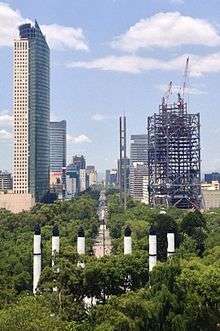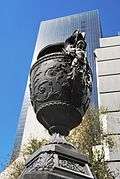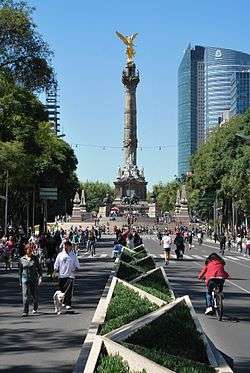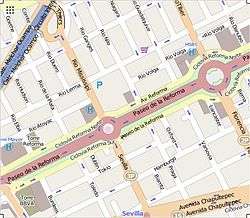Paseo de la Reforma
 Paseo de la Reforma as seen from Chapultepec Castle, July 2013 | |
| Length | 14.7 km. |
|---|---|
| Location | Mexico City, Mexico |

Paseo de la Reforma is a wide avenue that runs diagonally across the heart of Mexico City. It was designed by Ferdinand von Rosenzweig in the 1860s and modeled after the great boulevards of Europe,[1] such as the Ringstrasse in Vienna and the Champs-Élysées in Paris. After the French intervention in Mexico overthrew the constitutional President Benito Juárez, the newly crowned Emperor Maximilian made his mark on the conquered city. He commissioned a grand avenue linking the city center with his imperial residence, Chapultepec Castle, which was then on the southwestern edge of town. The project was originally named Paseo de la Emperatriz ("Promenade of the Empress") in honor of Maximilian's consort and second cousin Empress Carlota. After her return to Europe and Maximilian's subsequent execution, the restored Juárez government renamed the Paseo in honor of the Reform War.
It is now home to many of Mexico's tallest buildings such as the Torre Mayor and others in the Zona Rosa. More modern extensions continue the avenue at an angle to the old Paseo. To the northeast it continues toward Tlatelolco, where it changes its name near the Plaza de las Tres Culturas. There it divides into Calzada de Guadalupe and Calzada de los Misterios that continue toward La Villa. Its western portion going west from Chapultepec Park passes south of Polanco on its way through the affluent neighborhood of Lomas de Chapultepec and then into Cuajimalpa and Santa Fe on the outskirts of the city, although when it reaches this point it is more a highway than a promenade.
Monuments
Many monuments to people and events in Mexico's history and the history of the Americas are situated on and along Reforma. Honored people include the Niños Héroes – the Heroic Cadets of the Battle of Chapultepec – with a particularly grand monument in the entrance of Chapultepec Park, a Monument to Cuauhtémoc, Simón Bolívar, José de San Martín and Christopher Columbus. There is also a fountain with sculptures that commemorate the nationalization of Mexico's oil reserves and industry in 1938, and the Diana the Huntress fountain that includes a statue featuring the Roman goddess Diana originally named The Arrow Thrower of the North Star.
One of the most famous monuments of the Paseo is the Angel of Independence – a tall column with a gilded statue of a Winged Victory (that bears resemblance with an angel, therefore its common name) on its top and many marble statues on its base depicting the heroes of the Mexican War of Independence, built to commemorate the centennial of Mexico's independence in 1910. The base contains the tombs of several key figures in Mexico's war of independence.
Near the central section of Reforma, across from the Alameda, is the Monument to the Revolution. This is an enormous dome supported by four arches. It was originally planned, by Porfirio Díaz, to be a part of a new parliament building, but it never was completed because of the start of the Mexican Revolution. After Díaz's overthrow it became a monument to the revolution that deposed him. The remains of Francisco I. Madero and several other heroes of the Mexican Revolution are buried here.
Architecture
During President Díaz's regime, Paseo de la Reforma became very popular among elite families as a residential area. Few of these original houses built in different European architectural styles remain and office blocks have been built on their place over the years. Although there is no single block that has kept its former architecture, a couple of scattered buildings show the opulence enjoyed by the elites during Porfirio Díaz' regime.
Although most of the modern buildings are unremarkable, the Art Deco Loteria Nacional building and the functionalist IMSS building are an exception. Today Paseo de la Reforma houses offices ranging from the Mexican Federal Government to Banks and brokerage houses.
The newer buildings show a mix of contemporary styles and the commonly used style for office buildings.
Other places of interest

Reforma is home to the embassies of the United States (Reforma 305), Colombia (379), Japan (395), the European Union (1675), and Peru (2601). The Mexican stock exchange building (Bolsa Mexicana de Valores) and the former trading floor are on Reforma, as are several museums which are part of Chapultepec Park, including the National Museum of Anthropology, the Modern Art Museum, and the Tamayo Contemporary Art Museum. Another important highlight is the Chapultepec Zoo which is home to more than 2000 animals from more 200 different species and the Castle of Chapultepec, which currently house the Museo Nacional de Historia.
Today

Today, the Reforma is filled with tourist attractions, luxurious restaurants and hotels, office buildings, public art exhibitions, and new construction.
Reforma has become a traditional place for the Mexicans to celebrate or protest. Most protest rallies commonly go along Reforma from El Ángel to the Zócalo or from the Zócalo to Los Pinos. Many parades also make their way through Reforma. El Ángel roundabout is a traditional place for the celebration of the victories of the national football team, mostly during World Cups.
Since 2003, Mexico City's government started a renewal program for Paseo de la Reforma. It included the maintenance of the existent gardens and the creation of new ones, the intensive cleaning and sweeping of streets and sidewalks, the construction of new pink quarry sidewalks and benches, the creation of access bays in the Zoo, lake and Modern Art Museum for touristic and school buses, the installation of new lighting, the moving of the monument to Cuauhtémoc to the crossing of Insurgentes Avenue and Paseo de la Reforma, the construction of prism shaped concrete structures in the median which also have plants and flowers, the promotion of Reforma as a cultural walk organizing different expositions along the avenue sidewalks, and the maintenance of the monuments, sculptures and fountains. Also, a touristic route that goes from Chapultepec Park to the Historic Center along Reforma was established by a double deck bus called Turibus.
With the renewal project, new life has come to the avenue. It has become a main attraction of the city and the most expensive one to build on. However, after many of Mexico City's banks and business left Paseo de la Reforma for the Santa Fe business district in the last decade, the boulevard has been the center of a real estate renaissance. Remarkable buildings built in recent years are Torre Mayor, Torre HSBC in the Ángel roundabout, Torre Libertad with St. Regis Hotel in the Diana fountain roundabout, and Reforma 222 designed by famous Mexican architect Teodoro González de León at Reforma and Havre St. Recently opened mix-used developments include a Ritz-Carlton Hotel & Residences and a Park Hyatt Hotel & Residences.
The Japanese Embassy is located on Paseo de la Reforma. The American Embassy is also currently located on Reforma, however, the American delegation is in the process of transferring by 2020 to the Nuevo Polanco area.
Five skyscrapers are under construction along the boulevard near the entrance to Chapultepec Park and the Diana the Huntress fountain: Torre Reforma (244m), Punto Chapultepec (238m), Torre BBVA Bancomer (235m), and Torre Diana (158m).
Gallery
 Reforma and The Angel as seen from the Torre Mayor
Reforma and The Angel as seen from the Torre Mayor Monumento a Colón
Monumento a Colón

 Bronze vases are placed amongst the monuments
Bronze vases are placed amongst the monuments Monument to the Heroic Cadets, with Chapultepec Castle in the background
Monument to the Heroic Cadets, with Chapultepec Castle in the background Base of the Cuauhtémoc monument
Base of the Cuauhtémoc monument Cocodrilo by Leonora Carrington
Cocodrilo by Leonora Carrington Plaza Residence
Plaza Residence- Torre del Caballito, named after El Caballito by Sebastián. The sculpture was erected in honor of the Equestrian statue of Charles IV of Spain formerly located at this intersection of Reforma.
See also
- The Paseo, a 19-mile avenue in the center of Kansas City, Missouri, U.S., modeled after Paseo de la Reforma.
- Avenida Presidente Masaryk, an upscale shopping district in Polanco, Miguel Hidalgo borough, Mexico City.
- Paulista Avenue, a comparable Latin American avenue in São Paulo, Brazil.
| Wikimedia Commons has media related to Paseo de la Reforma. |
References
- ↑ "Excélsior en la Historia: La metamorfosis de Paseo de la Reforma". Excélsior. Retrieved 10 April 2015.
Coordinates: 19°26′04″N 99°09′07″W / 19.43444°N 99.15194°W

